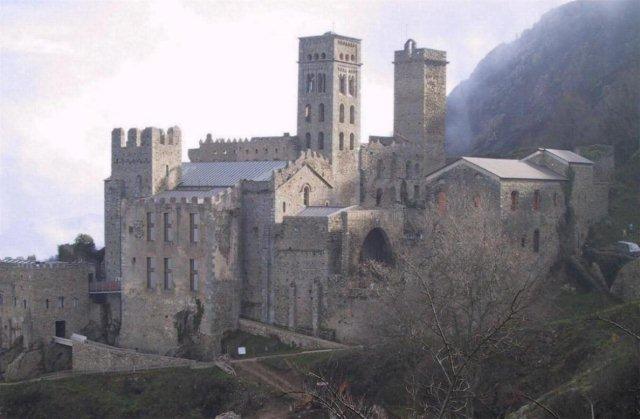| St. Pere de Rodes | |
|
|
|
|
1/2 Day |
|
|
The
Benedictine monastery of Sant Pere de Rodes is an important former
monastery. It has been constructed in the side of the Verdera mountain
below the ruins of the castle of Sant de Verdera that had provided
protection for the monastery. It offers exceptional views over the bay of
Llançà, to the north of Cap de Creus. Near the monastery Santa Creu de
Rodes is the ruins of a medieval town, of which its preRomanesque style
church is the only remains dedicated to Saint Helena. The
true origin of the monastery is not known, which has given rise to
speculation and legend; such as its foundation by monks who disembarked in
the area with the remains of Saint Peter and other saints, to save them
from the Barbarian hordes that had fallen on Rome. Once the danger had
passed the Pope Boniface IV commanded them to construct a monastery. Nevertheless
the first documentation of the existence of the monastery dates 878, it
being mentioned as a simple monastery cell consecrated to Saint Peter, but
it is not until 945 when an independent Benedictine monastery was founded,
prevailed over by an abbot. Bound to the County of Empúries it reached
its maximum splendor between the XI and XII centuries until its final
decay in 17th century. Its increasing importance is reflected in its
status as a point of pilgrimage. In
the 17th Century XVII it was sacked in several occasions and in 1793 was
deserted by the Benedictine community which was transferred to Vila-sacred
and finally settled in Figueres in 1809 until it was dissolved. The
monastery was declared a national monument in 1930. In 1935 the
Generalitat of Catalonia initiated the first restoration work. The
buildings are constructed in terraces, given its location. Cloisters of
XII century form the central part of the complex. Around them the rest of
constructions are distributed. The Church, consecrated in the year 1022,
is the best exponent of the Romanesque style and without comparison with
others of its time. Detailing features plants with three bays and a vault.
These are bordered by a double column with capitals influenced by the
Carolingian Style. The double column support arches separating the bays.
The columns and pillars have been taken from a former Roman building. The
bay is splendid with large dimensions with an arch in the apse; this is
continued in the two lateral bays. Under the apse is a crypt. The church
synthesizes a number of original styles including Carolingian, Romanesque
and Roman. The monastery is considered one of the best examples of
Romanesque architecture in Catalonia. In the western facade of the
monastery is a XII Century bell tower, a square shape it is influenced by
the Lombard from the previous century. To the side is a defensive tower,
that was probably began in the X Century but finished later after several
modifications. Cap
de Creus Cape
of crosses in Catalan is located at the far NE of Catalonia, some 25 km
south from the French border. The nearest town is Figueres, capital of the
Alt Empordà and birthplace of Salvador Dalí. It is a peninsula of 190
square kilometers of an extraordinary landscape value; a very rocky dry
region, with almost no trees, in contrast with a seaside rich in minuscule
creeks of deep blue sea to anchor. Mountains are the last eminences of the
Pyrenees which make the natural border between France and Spain. The
region is frequently swept by awful north wind "tramontana" (beyond
mountains) which has caused many naval disasters. Cadaqués is the most
well known village, home of artists and writers, with sophisticated and
snobbish atmosphere, near Port Lligat where Dalí built his home in a
paradise small bay. El Port de la Selva, with a little fishing harbor is
less exploited, with good gastronomic recourses and pleasant terraces.
Fantastic Sant Pere de Rodes stands out at 500 m of altitude with
spectacular views of the Cap and the Pyrenees. It is a 11th century
monastery whose first structures date from about 750 AD. It is a
magnificent building in Catalan roman style with imposing dimensions and
some pre-Romanic painting rests. Cap
de Creus is the easternmost point of mainland Catalonia. The legend tells
that the Cap de Creus was made by Hercules. |
|
